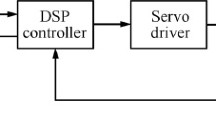Abstract
This paper presents a method to identify and control electro-pneumatic servo drives in a real-time environment. Acquiring the system’s transfer function accurately can be difficult for nonlinear systems. This causes a great difficulty in servo-pneumatic system modeling and control. In order to avoid the complexity associated with nonlinear system modeling, a mixed-reality environment (MRE) is employed to identify the transfer function of the system using a recursive least squares (RLS) algorithm based on the auto-regressive moving-average (ARMA) model. On-line system identification can be conducted effectively and efficiently using the proposed method. The advantages of the proposed method include high accuracy in the identified system, low cost, and time reduction in tuning the controller parameters. Furthermore, the proposed method allows for on-line system control using different control schemes. The results obtained from the on-line experimental measured data are used to determine a discrete transfer function of the system. The best performance results are obtained using a fourth-order model with one-step prediction.
Similar content being viewed by others
References
Richard E, Scavarda S (1996) Comparison between linear and nonlinear control of an electropneumatic servodrive. J Dyn Syst Meas Control 118:445–452
Keller H, Isermann R (1993) Model-based nonlinear adaptive control of a pneumatic actuator. Control Eng Pract 1:505–511
Wang J, Pu J, Moore PR (1999) A practical control strategy for servo-pneumatic actuator systems. Control Eng Pract 7:1483–1488
Wang J, Pu J, Moore PR (1999) Accurate position control of servo pneumatic actuator systems: an application to food packaging. Control Eng Pract 7:699–706
Carducci G, Giannaccaro NI, Messina A, Rollo G (2006) Identification of viscous friction coefficients for a pneumatic system model using optimization methods. Math Comput Sim 71:385–394
Daw N, Wang J, Wu QH (2003) Parameter identification for nonlinear pneumatic cylinder actuators. In: Zinober ASI, Owens DH (ed) Nonlinear and adaptive control NCN4. Springer, New York, pp 77–88
Wang J, Wang JD, Daw N, Wu QH (2004) Identification of pneumatic cylinder friction parameters using genetic algorithms. IEEE/ASME Trans Mechatron 9(1):100–107
Ziaei K, Sepehri N (2000) Modeling and identification of electrohydraulic servos. Mechatronics 10:761–772
Angerer BT, Hintz C, Schröder D (2004) Online identification of a nonlinear mechatronic system. Control Eng Pract 12:1465–1478
Söderström T, Stoica P (1989) System identification. Prentice-Hall, London
Ljung L (1999) System identification: theory for the user, 2nd ed. Prentice-Hall, Englewood Cliffs
Yan M, Lee M, Yen P (2005) Theory and application of a combined self-tuning adaptive control and cross-coupling control in a retrofit milling machine. Mechatronics 15:193–211
Östring M, Gunnarson S, Norrlöf M (2003) Closed-loop identification of an industrial robot containing flexibilities. Control Eng Pract 11:291–300
Johansson R, Robertsson A, Nilsson K, Verhaegen M (2000) State-space system identification of robot manipulator dynamics. Mechatronics 10:403–418
Tutunji T, Molhem M, Turki E (2007) Mechatronic systems identification using an impulse response recursive algorithm. Sim Model Pract Theory 15:970–988
Abdrabbo S, Tutunji (2007) Identification and analysis of hydrostatic transmission system. Int J Adv Manuf Technol DOI 10.1007/S00170-007-0966-3
Ke J, Wang J, Jia N, Yang L, Wu QH (2005) Energy efficiency analysis and optimal control of servo pneumatic cylinders. In: Proceedings of the 2005 IEEE International Conference on Control Applications (CCA), August 2005, Toronto, Canada, part 1, pp 541–546
Hamiti K, Voda-Besancon A, Roux-Buisson H (1996) Position control of a pneumatic actuator under the influence of stiction. Control Eng Pract 4(8):1079–1088
Shearer JL (1956) Study of pneumatic process in the continuous control of motion with compressed air. Trans ASME 78:233–249
Ljung L (2007) System Identification Toolbox 7, user’s guide. Mathworks Publications
Kiam HA, Chong G, Yun L (2005) PID control system analysis, design, and technology. IEEE Trans Control Syst Technol 13(4):559–576
Author information
Authors and Affiliations
Corresponding author
Rights and permissions
About this article
Cite this article
Saleem, A., Abdrabbo, S. & Tutunji, T. On-line identification and control of pneumatic servo drives via a mixed-reality environment. Int J Adv Manuf Technol 40, 518–530 (2009). https://doi.org/10.1007/s00170-008-1374-z
Received:
Accepted:
Published:
Issue Date:
DOI: https://doi.org/10.1007/s00170-008-1374-z




